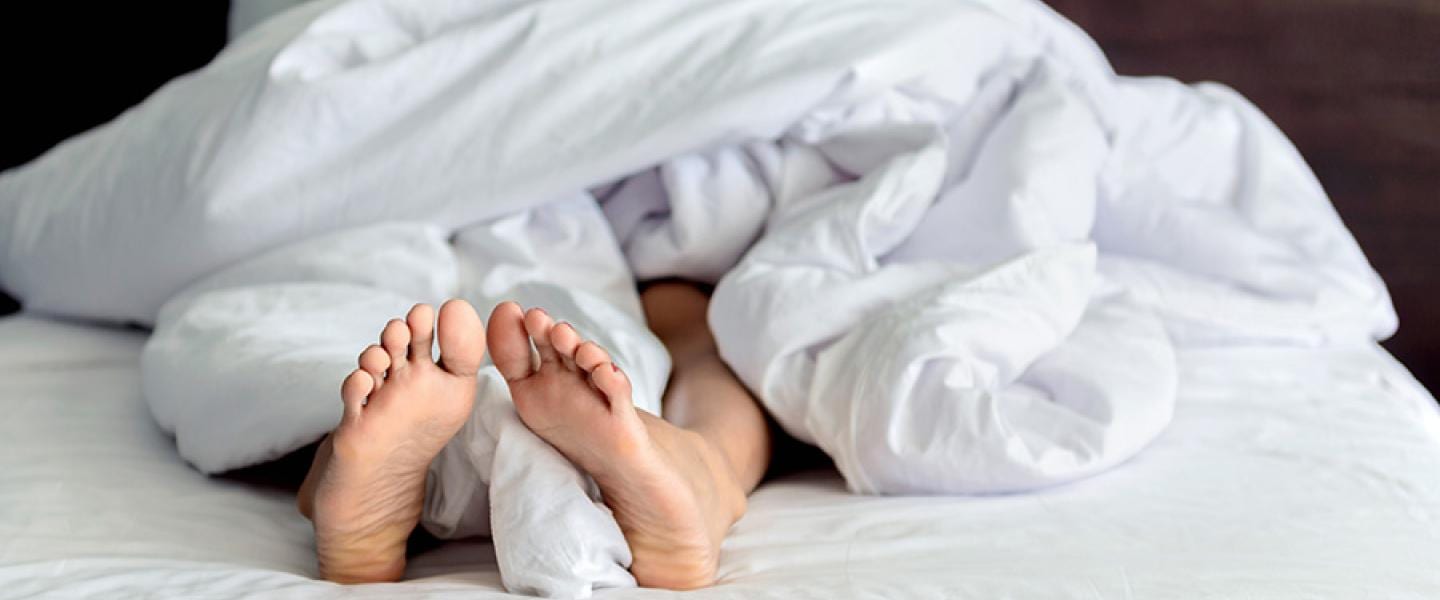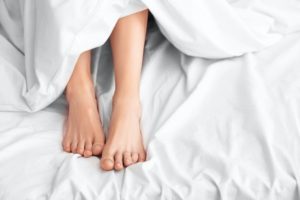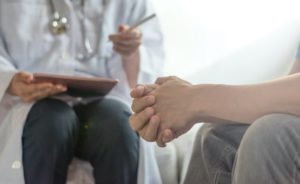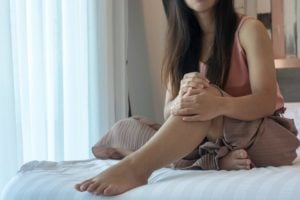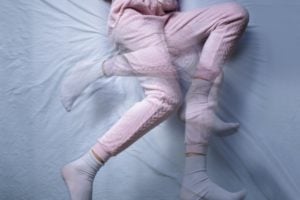Home Remedies for Restless Legs Syndrome
People with restless legs syndrome (RLS) who only have mild symptoms or occasional flare ups may find relief with home remedies and lifestyle changes. While these remedies can be effective, working with a doctor is necessary to determine the best treatment for RLS.
Restless legs syndrome is a sleep-related movement disorder that affects up to 15% of people in the United States. A person with RLS experiences hard-to-describe, uncomfortable feelings in their legs while resting. This is accompanied by a strong urge to move the legs, which usually gets worse at night when lying in bed. Movement provides momentary relief, but the discomfort quickly returns.
What Restless Legs Syndrome Home Remedies May Provide Relief?
There are a variety of home remedies and lifestyle changes that can improve symptoms for people with mild or moderate restless legs syndrome. Referred to as non-pharmacological treatment, these measures may be recommended for people who experience symptoms up to twice a week and may be combined with medications as needed.
For people with more frequent or severe symptoms, doctors may recommend a combination of home remedies and long-term medication.
“Don’t wait to bring RLS up with your health care provider. There are many behavioral and pharmacologic ways to treat RLS. Make sure to take your most current medication list including all supplements when you discuss RLS.”
Dr. Abhinav Singh, Sleep Physician
Caring for the Legs and Feet
Self-care measures done around bedtime may help lessen leg discomfort for people with RLS and the urge to move the limbs. These include:
- Massaging the legs and feet
- Taking a warm bath
- Taking a cool bath
- Relaxing in a whirlpool tub
- Resting the legs on a heating pad
- Putting a cold pack or ice pack on the legs
Reduce and Manage Stress
For some people with RLS, symptoms get worse during times of stress. They may find relief by trying meditation or yoga. Other ways to manage stress include:
- Exercising 30 minutes a day
- Wellness apps that teach mindfulness, deep breathing, or muscle relaxation
- Talking things over with friends or family members
- Getting help from a mental health professional
Exercise Regularly
by the symptoms of RLS, exercising regularly during the day can translate to relief at night. In fact, research shows that people who are not very active are more likely to develop RLS. It is best to get a doctor’s approval before beginning a new exercise routine.
Many types of exercise can be beneficial for a person trying to reduce their RLS symptoms, including:
- Walking
- Yoga
- Stretching
- Dancing
- Taking a fitness class
Another way to increase activity during the day is to reduce screen time . This can be done by setting limits on time spent watching television or movies, playing video games, or surfing the internet.
Avoid Triggers
It can also be helpful to avoid substances that trigger symptoms of restless legs syndrome.
- Caffeine: Caffeine can aggravate symptoms for some people who have RLS. In addition to coffee, caffeine is found in tea, cola soft drinks, energy drinks, chocolate, and some over-the-counter medications.
- Alcohol: Drinking alcoholic beverages increases symptoms in some people with RLS.
- Tobacco: Tobacco and nicotine may cause RLS symptoms to flare up. Besides cigarettes, tobacco-containing products include cigars, e-cigarettes, and smokeless tobacco.
- Certain medications: Antihistamines in nonprescription cold and allergy medications can cause RLS symptoms to get worse. Some antidepressants also have an effect on RLS symptoms, but no one should stop a medication without first consulting their doctor.
Restless Legs Syndrome Home Remedies for Females
There are currently no female-specific home remedies for RLS. While RLS is more common in women and people assigned female at birth, this may be because up to 25% of pregnant people experience the disorder.
Some RLS treatments and home remedies are not appropriate during pregnancy. Doctors usually do not prescribe medications for pregnant people who have RLS symptoms. Instead, they may recommend iron supplements and lifestyle changes that include regular physical activity. People who are pregnant should limit time in a hot tub or very hot bath to 10 minutes.
What Causes Restless Legs Syndrome?
Researchers believe RLS may be caused by conditions in the brain. One of these conditions is a reduced level of iron in the brain , which differs from iron deficiency that can be diagnosed with a blood test. Research also shows an issue with how the brain uses dopamine may be linked to RLS.
While doctors usually do not know what causes a person to develop RLS, it does run in families, accounting for at least one-third of cases. When RLS is linked to family history, a person usually develops symptoms before age 40.
“While exact causes are not fully understood, it probably involves a dysfunction in the brain’s dopamine signaling and may be associated with genetic and environmental factors.”
Dr. Abhinav Singh, Sleep Physician
For some people, RLS may be related to an underlying medical condition, emphasizing the importance of seeing a doctor for an accurate diagnosis and appropriate treatment.
Doctors often begin treatment for RLS by addressing underlying medical conditions. Conditions associated with RLS include:
- Diabetes
- Sleep apnea
- Kidney disease
- Peripheral neuropathy from diabetes, alcohol use, and other conditions
- Parkinson’s disease, particularly for people of European and Asian ancestry
- Diseases of the spinal cord
- Multiple sclerosis
- Pregnancy
- Obesity
- Iron deficiency

Treatments for Restless Legs Syndrome
Treatment of restless legs syndrome is aimed at relieving symptoms, improving sleep, and making sure the disorder does not have a negative impact on daytime activities. People who are diagnosed with RLS should talk to their doctor about taking an iron supplement.
Doctors may prescribe medication if treating underlying conditions, making lifestyle changes, and self-care measures do not bring relief. People with RLS may need to try different medications before they find one that works. Sometimes a medication that provides relief may stop working over time.
RLS medications for moderate to severe RLS can be grouped according to how they work in the body:
- Anti-seizure and neuropathic medications
- Dopamine-related medications
- Pain and anxiety medications
There are also prescription medical devices that go around the foot or under the legs and provide relief with compression or vibrations.
How to Sleep Better With Restless Legs Syndrome
Relaxing before bedtime and following other sleep hygiene recommendations can help a person with RLS get a good night’s sleep. Sleep deprivation can cause or worsen symptoms, and most people with RLS also have insomnia .
When the uncomfortable leg sensations of RLS make it hard to relax at bedtime or a person with RLS is having difficulty sleeping, they can try:
- Keeping the sleep area dark and quiet
- Putting electronic devices away and not watching TV or looking at any screens before bedtime
- Not drinking alcoholic beverages or using tobacco products before bedtime
- Cutting out caffeine-containing foods and beverages after lunchtime
- Going to sleep and waking up at the same times every day
- Limiting naps to no more than one hour and not napping in the late afternoon
- Planning exercise for between four and six hours before bedtime
Medical Disclaimer: The content on this page should not be taken as medical advice or used as a recommendation for any specific treatment or medication. Always consult your doctor before taking a new medication or changing your current treatment.
References
11 Sources
-
Silber, M. H., Buchfuhrer, M. J., Earley, C. J., Koo, B. B., Manconi, M., Winkelman, J. W., & Scientific and Medical Advisory Board of the Restless Legs Syndrome Foundation. (2021). The management of restless legs syndrome: An updated algorithm. Mayo Clinic Proceedings, 96(7), 1921–1937.
https://pubmed.ncbi.nlm.nih.gov/34218864/ -
Bozorg, A. M. (2022, January 6). Restless leg syndrome. Medscape., Retrieved January 25, 2023, from
https://emedicine.medscape.com/article/1188327-overview#showall -
A.D.A.M. Medical Encyclopedia. (2021, July 26). Restless legs syndrome. MedlinePlus., Retrieved January 25, 2023, from
https://medlineplus.gov/ency/article/000807.htm -
Schwab, R. J. (2022, May). Periodic limb movement disorder (PLMD) and restless legs syndrome (RLS). Merck Manual Consumer Version., Retrieved January 25, 2023, from
https://www.merckmanuals.com/home/brain,-spinal-cord,-and-nerve-disorders/sleep-disorders/periodic-limb-movement-disorder-plmd-and-restless-legs-syndrome-rls -
UpToDate. (n.d.). Patient education: Restless legs syndrome (The basics). UpToDate., Retrieved January 25, 2023, from
https://www.uptodate.com/contents/restless-legs-syndrome-the-basics -
National Institute of Neurological Disorders and Stroke. (2022, October 3). Restless legs syndrome fact sheet., Retrieved January 25, 2023, from
https://www.ninds.nih.gov/restless-legs-syndrome-fact-sheet -
A.D.A.M. Medical Encyclopedia. (2021, May 3). Physical activity. MedlinePlus., Retrieved January 25, 2023, from
https://medlineplus.gov/ency/article/001941.htm -
Silber, M. H. (2022, June 29). Management of restless legs syndrome and periodic limb movement disorder in adults. In H. I. Hurtig, & A. Y. Avidan (Eds.). UpToDate., Retrieved January 25, 2023, from
https://www.uptodate.com/contents/management-of-restless-legs-syndrome-and-periodic-limb-movement-disorder-in-adults -
Ondo, W. (2022, May 18). Clinical features and diagnosis of restless legs syndrome and periodic limb movement disorder in adults. In H. I. Hurtig, & A. Y. Avidan (Eds.). UpToDate., Retrieved January 25, 2023, from
https://www.uptodate.com/contents/clinical-features-and-diagnosis-of-restless-legs-syndrome-and-periodic-limb-movement-disorder-in-adults -
NIH Office of Communications and Public Liaison. (2021, July). Disruptive leg movement? Managing restless legs syndrome., Retrieved January 25, 2023, from
https://newsinhealth.nih.gov/2021/07/disruptive-leg-movement -
Winkelman, J. W. (2022, August 29). Overview of the treatment of insomnia in adults. In R. Benca (Ed.). UpToDate., Retrieved January 25, 2023, from
https://www.uptodate.com/contents/overview-of-the-treatment-of-insomnia-in-adults


